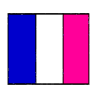 COURSE CONTENTS
COURSE CONTENTS
|
|
Emphasis on Vocabulary,
Phonetics, Pronunciation, Reading, Grammar, Sentence Generation and Conversational
French
|
Read and Speak French/CDROM teaches
French
Vocabulary,
Grammar,
Sentence
Generation, Pronunciation
and Reading to
beginner,
intermediate and advanced students. The course is contained
in a CDROM that is installed on the student's computer and is designed
to teach adults or children. This French course is easy and fun to
use, requires only the mouse and employs hundreds of custom-made color
pictures, native speaker pronunciation and illustrated printouts.
The course assumes no prior knowledge of French and covers the language
material taught in about 600 school hours. Course format provides
the presentation of learning material using multicolor French text to highlight
dinstict word parts, illustrating custom-made color pictures, clickable
French sound and explanatory English text. Understanding of the material
is evaluated through interactive exercises that enhance comprehension and
incorporate multicolor French and English texts, pictures and sounds.
The course provides about 300 lessons, thousands of exercises and takes
about 150 hours to complete.
This course is designed to be useful to children or adults (age greater
than 5 years). Course is suitable for use at home or in schools.
|
Introduction
|
Provides French words that appear
in English and explains the origins of the French language |
Presents the origins of the French language and its occasional resemblance
with English.
|
Alphabet
|
Teaches alphabet letters and
their sounds |
Presents the French alphabet letters with their sound and tests acquired
knowledge through 31 interactive exercises.
Exercise 1 focuses on the recognition
of the alphabet sounds.
Exercise 2 focuses on the spelling
of 30 words where each letter is pronounced as an alphabet letter.
|
Phonetics
|
Teaches the basic sounds and
how to pronounce letters and letter combinations |
All basic sounds and letter combinations are provided along with (a) their
pronunciation, (b) their phonetic spelling and (c) example words. Example
words are broken into syllables, each syllable can be heard individually
and the individual syllables are slowly fused together to make the word
pronunciation. Acquired knowledged is tested through 204
interactive exercises.
|
Reading and Vocabulary
|
Teaches vocabulary, reading,
pronunciation and how to relate text to its pronunciation |
There are 46 lessons and each lesson focuses on 12 texts (nouns with their
articles, verbs, phrases or sentences). The texts introduce to the learner
various contexts and situations: days, months, seasons, names, relatives,
professions, numbers, and many more. Acquired knowledge is tested
through 3,312 interactive exercises.
Each text has its color picture, its French pronunciation, its French
text, and its English translation.
Each lesson has 6 exercises. The exercise score is increased if the
response is correct with the first try.
Exercise 1 tests and teaches sound
comprehension.
Exercise 2 tests and teaches sound
discrimination.
Exercise 3 tests and teaches reading
comprehension.
Exercise 4 tests and teaches introductory
understanding of gender.
Exercise 5 tests and teaches basic
sounds and their spelling.
Exercise 6 practices handwriting.
|
Accents and Punctuation
|
Teaches the marks of the language |
For each of the Punctuation marks and Spelling marks of the French language,
in this section you find English text along with illustrated French text
that can talk upon clicking. Acquired knowledge is tested through
24
interactive exercises. The section explains the following:
(a) spelling of the mark name,
(b) pronunciation of the mark name,
(c) mark symbol,
(d) brief description of mark usage.
Exercise 1 ("Fill in the Blanks")
tests and teaches understanding of French sentence structure.
Exercise 2 ("Unscramble the Words")
tests and teaches Sentence Generation.
|
Structure of the Language
|
Summary of how French differs
from English |
Thorough illustrated explanation of the major differences between French
and English. Many explanatory French sentences are provided.
The sentences have a color picture, an English translation and you can
click to hear their sound. Acquired knowledge is tested through
24
interactive exercises. In this section you find explanations
of the following:
(a) gender and number (articles, adjectives and nouns),
(b) conjugation patterns,
(c) the basic tenses: present, imperfect, present perfect, simple future.
Exercise 1 ("Fill in the Blanks")
tests and teaches understanding of French sentence structure.
Exercise 2 ("Unscramble the Words")
tests and teaches Sentence Generation.
|
Parts of Speech
|
Teaches the Parts of Speech
and gives examples of their use in sentences |
Thorough explanation for each part of speech.
Key chapters are:
ARTICLES (18
interactive exercises)
 elision
elision
 definite, indefinite, partitive articles and contractions
definite, indefinite, partitive articles and contractions
NOUNS (24
interactive exercises)
 gender and number
gender and number
ADJECTIVES (78
interactive exercises)
 agreement and position of descriptive adjectives
agreement and position of descriptive adjectives
 possessive, demonstrative, indefinite, interrogative, exclamative, numeral
adjectives
possessive, demonstrative, indefinite, interrogative, exclamative, numeral
adjectives
PRONOUNS (78
interactive exercises)
 position of personal pronouns
position of personal pronouns
 personal, possessive, demonstrative, relative, indefinite, interrogative,
exclamative, adverbial pronouns
personal, possessive, demonstrative, relative, indefinite, interrogative,
exclamative, adverbial pronouns
VERBS (534
interactive exercises)
 39 example verbs conjugated each at 13 tenses
39 example verbs conjugated each at 13 tenses
 negative, interrogative and comparative construction
negative, interrogative and comparative construction
 conjugation:
conjugation:
- active and passive voice
- moods: imperative, indicative, participle,
infinitive and subjunctive
 tenses:
tenses:
- of the indicative: present, past, past
progressive, present conditional, future, present perfect, past perfect,
future perfect and past conditional
- of the participle: present and past
- of the subjunctive: present
- of the imperative: present
 reflexive verbs
reflexive verbs
 impersonal verbs
impersonal verbs
 auxiliary verbs and agreement of past participle
auxiliary verbs and agreement of past participle
ADVERBS (48
interactive exercises)
 use in example sentences
use in example sentences
 adverbs derived from adjectives
adverbs derived from adjectives
PREPOSITIONS (54
interactive exercises)
 use in example sentences
use in example sentences
 "de" and "à"
"de" and "à"
CONJUNCTIONS (48
interactive exercises)
 use in example sentences
use in example sentences
INTERJECTIONS (48
interactive exercises)
 use in example sentences
use in example sentences
Exercise 1 ("Fill in the Blanks")
tests and teaches understanding of French sentence structure.
Exercise 2 ("Unscramble the Words")
tests and teaches Sentence Generation.
|
Dialogs
|
Provides examples of French
dialogs |
Follow the romantic adventures of Michèle and Benoît through
9 dialogs mirroring everyday life situations (about 500 sentences).
 At the railway station
At the railway station
 On the telephone
On the telephone
 At the restaurant
At the restaurant
 At the hotel
At the hotel
 Lost in town
Lost in town
 At the store
At the store
 Reunion
Reunion
 In the taxi
In the taxi
 Back to Lille
For each word of this mini-dictionary (over 1000 entries), you find the
following:
Back to Lille
For each word of this mini-dictionary (over 1000 entries), you find the
following:
(a) spelling
(b) picture
(c) phonetic spelling
(d) sound
The mini-dictionary works both ways: French-English or English-French.
Provides 348 interactive exercises
that test the following competences:
(a) Phonetics and spelling
(b) Reading comprehension
(c) Listening comprehension
SAMPLE VOCABULARY
LESSON
|
|
|
|
|
un
crayon
(a
pencil)
|
écrire
(to
write)
|
líenveloppe
(the
envelope)
|
|
|
|
|
|
un
journal
(a
newspaper)
|
des
lettres
(some
letters)
|
lire
(to read)
|
|
|
|
|
|
le
livre
(the
book)
|
le
papier
(the
paper)
|
réfléchir
(to
think)
|
|
|
|
|
|
savoir
(to
know)
|
le
taille-crayons
(the
pencil
sharpener)
|
le
timbre
(the
stamp)
|
SAMPLE LESSON ON PERSONAL PRONOUNS
| Pronoun |
Notes |
Sentence |
Picture |
je
I |
|
Je suis français.
I am French. |
 |
tu
you |
The informal pronoun "tu" is used to address people
of same age or social rank. |
Qui es-tu?
Who are you? |
 |
vous
you |
The formal pronoun "vous" is used when talking tom
somebody older or of higher social rank. |
Qui êtes-vous?
Who are you? |
 |
elle
she |
|
Elle est jolie.
She is pretty. |
 |
il
he |
|
Il est italien.
He is Italian. |
 |
nous
we |
|
Nous sommes français.
We are French. |
 |
on
we |
The informal pronoun "on" is more common than "nous"
in coversational French. |
On habite en France.
We live in France. |
 |
vous
you |
|
Vous êtes allemands?
Are you German? |
 |
elles
they (feminine) |
|
Elles sont américaines.
They are American. |
 |
ils
they (masculine) |
|
Ils sont professeurs.
They are teachers. |
 |
Ordering
Customer Comments
*Jusina Ilochi, Great Britain, 2 February 2008, adomkyaagba@yahoo.com
I enjoyed the program very much.
*Yolanda C Garza, USA, 28 November 2004, ygarza@twcny.rr.com
By the way, it is a great program.
*Ben Okah, Nigeria, 1 August 2004, balkonltd@yahoo.co.uk
The CD is wonderful.
*Joanna Leigh, UK, 20 May 2004, j.leigh30@ntlworld.com
I think it is a great fun and pleasure to learn.
*Andrew Cruickshanks, UK, 16 February 2004, webmaster@nihon-to.info
I am very pleased with your learn French CD.
*Michael
Butler, CANADA, 20 November 2003, michael.butler@sympatico.ca
I have two boys and we all enjoy working with the program.
*Arthur Lindsey, USA, 19 February 2003, trailhiker@fuse.net
I am thoroughly impressed with the "Read and Speak French" course I received
this morning. I am going to have a great time learning French from this course.
*Danny Nevins, USA, 30 October 2002, dan65251@aol.com
I love the CDROM!
*Sara Ortiz, USA, 29 December 2001, sarilla_4@hotmail.com
Hello! I think the CD Rom is very good for learning French. I've had a
nice time.
*Godfried Lindeyer, USA, 12/08/01, glindeyer@hotmail.com
I think that this is one of the best courses on the market.
I have reviewed a lot of other cheaper courses and found them lacking.
My wife is home schooling out two little children, aged 4 and 6. Most
courses start at a much older level. If we can get them while they are
young, more information can sink in. To keep up with the children both
my wife and I will also use your disk.
*Paul Lueth, USA, 11/11/01, plalvegas@aol.com
I think the program is great! I have learned more French in the past three
weeks than I did German in High School, which I took for an entire year!